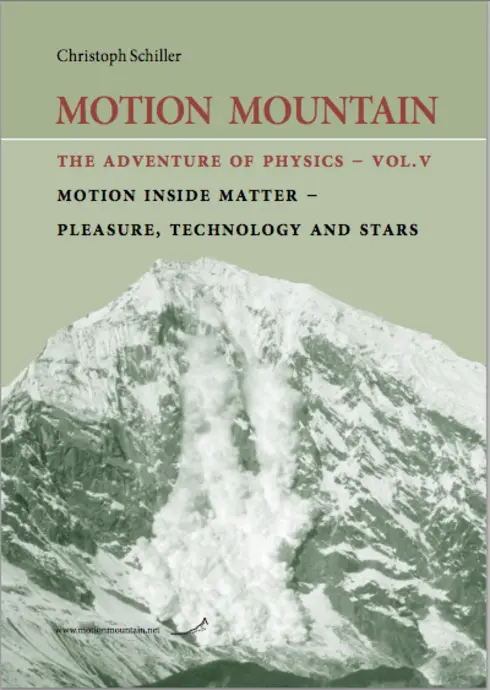
The Adventure of Physics - Vol. V: Motion Inside Matter - Pleasure, Technology, and Stars
No ratings
Christoph Schiller
Copyright Year:
Publisher: Motion Mountain
Language: English
Formats Available
Conditions of Use
![]() Attribution-NonCommercial-NoDerivs
Attribution-NonCommercial-NoDerivs
CC BY-NC-ND
Table of Contents
- 1 Motion For Enjoying Life
- 2 Changing The World With Quantum Effects
- 3 Quantum Electrodynamics – The Origin Of Virtual Reality
- 4 Quantum Mechanics With Gravitation – First Steps
- 5 The Structure Of The Nucleus – The Densest Clouds
- 6 The Sun, The Stars And The Birth Of Matter
- 7 The Strong Interaction – Inside Nuclei And Nucleons
- 8 The Weak Nuclear Interaction And The Handedness Of Nature
- 9 The Standard Model Of Particle Physics – As Seen On Television
- 10 Dreams Of Unification
- 11 Bacteria, Flies And Knots
- 12 Quantum Physics In A Nutshell – Again
About the Book
This book is written for anybody who is curious about nature and motion. Curiosity about how bodies, images and empty space move leads to many adventures. This volume presents the best adventures about the motion inside people, inside animals, and inside any other type of matter – from the largest stars to the smallest nuclei.
Motion inside bodies – dead or alive – is described by quantum theory. Quantum theory describes all motion with the quantum of action h, the smallest change observed in nature. Building on this basic idea, the text first shows how to describe life, death and pleasure. Then, the text explains the observations of chemistry, materials science, astrophysics and particle physics. In the structure of physics, these topics correspond to the three ‘quantum' points in Figure 1. The story of motion inside living and non-living matter, from the coldest gases to the hottest stars, is told here in a way that is simple, up to date and captivating.
In order to be simple, the text focuses on concepts, while keeping mathematics to the necessary minimum. Understanding the concepts of physics is given precedence over using formulae in calculations. The whole text is within the reach of an undergraduate.
In order to be up to date, the text is enriched by the many gems – both theoretical and empirical – that are scattered throughout the scientific literature.
In order to be captivating, the text tries to startle the reader as much as possible. Read- ing a book on physics should be like going to a magic show. We watch, we are astonished, we do not believe our eyes, we think, and finally we understand the trick. When we look at nature, we often have the same experience. Indeed, every page presents at least one sur- prise that makes the reader think. Also numerous interesting challenges are proposed.
The motto of the text, die Menschen stärken, die Sachen klären, a famous statement by Hartmut von Hentig on pedagogy, translates as: ‘To fortify people, to clarify things.' Clar- ifying things – and adhering only to the truth – requires courage, as changing the habits of thought produces fear, often hidden by anger. But by overcoming our fears we grow in strength. And we experience intense and beautiful emotions. All great adventures in life allow this, and exploring motion is one of them. Enjoy it!
About the Contributors
Author
Christoph Schiller, born in 1960, is European. Raised in Varese, he studied physics at the Universität Stuttgart and received his Ph.D. in physics at the Université Libre de Bruxelles, in the department of Ilya Prigogine. Christoph Schiller is an innovation manager. He is convinced that exploring and applying physics can provide as much pleasure as anything else in life - and he explains why in the present text. He started the Motion Mountain Textbook project in Yokohama in 1990, wrote most of the text in Eindhoven and is finishing it during his business trips.
